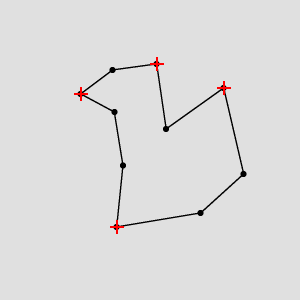You are here: Start » AVL.NET » AVL.PathTurnAngleLocalMaxima Method
AVL.PathTurnAngleLocalMaxima Method
Finds the local maxima of the profile of turn angles of a path.
| Namespace: | AvlNet |
|---|---|
| Assembly: | AVL.NET.dll |
Syntax
public static void PathTurnAngleLocalMaxima( AvlNet.Path inPath, AvlNet.TurnAngleDirection inAllowedTurnDirection, AvlNet.TurnAnglePrecision inResultPrecision, float inMinTurnAngle, float inMinDistance, float inSmoothingStdDev, out float[] outTurnAngleMaximaIndices, out AvlNet.Point2D[] outTurnAngleMaximaPoints, out float[] outTurnAngleMaximaAngles, out AvlNet.Path diagSmoothedPath, out AvlNet.Profile diagTurnAngleProfile )
Parameters
| Name | Type | Range | Default | Description | |
|---|---|---|---|---|---|
 | inPath | AvlNet.Path | Input path. | ||
 | inAllowedTurnDirection | AvlNet.TurnAngleDirection | All | Allows to detect only left-turns, only right-turns or both. Default value: All. | |
 | inResultPrecision | AvlNet.TurnAnglePrecision | Switches between pixel-precise or subpixel-precise detection of the found maxima. | ||
 | inMinTurnAngle | float | <0.0f, 180.0f> | 30.0f | Minimal value of a relevant angle. Default value: 30.0f. |
 | inMinDistance | float | <0.0f, INF> | 0.0f | Minimal distance on the path between two local maxima assuming each path segment has unit length. Default value: 0.0f. |
 | inSmoothingStdDev | float | <0.0f, INF> | 0.6f | Standard deviation of the gaussian smoothing applied to the input path. Default value: 0.6f. |
 | outTurnAngleMaximaIndices | float | Indices of found local maxima. | ||
 | outTurnAngleMaximaPoints | AvlNet.Point2D | Found local maxima of turn angle profile of the smoothed input path. | ||
 | outTurnAngleMaximaAngles | float | Turn angles of found local maxima. | ||
 | diagSmoothedPath | AvlNet.Path | Input path smoothed with gaussian kernel. | ||
 | diagTurnAngleProfile | AvlNet.Profile | Profile of turn angles at characteristic points of the smoothed input path. |
Description
The operation computes the profile of turn angles of a path and finds the local maxima of the profile having value at least inMinTurnAngle. The inAllowedTurnDirection parameter restricts kind of turns taken into consideration (left-turns only, right-turns only or both), while inResultPrecision determines the precision of the resulting maxima points. Found maxima have to be at least inMinDistance from each other (the distance is measured along the input path assuming each path segment has unit length).
Examples
 |
PathTurnAngleLocalMaxima run on the sample path with inAllowedTurnDirection = Right

